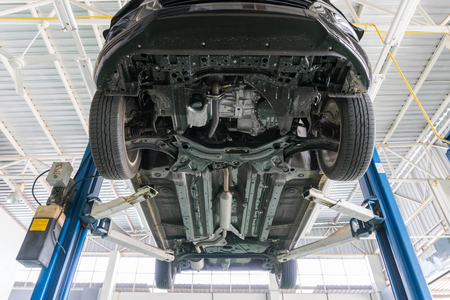1. Introduction to Performance Exhaust Systems
Performance exhaust systems play a crucial role in enhancing a vehicle’s engine power and overall efficiency. These systems are designed to optimize exhaust flow, reduce backpressure, and improve the engine’s ability to expel gases. Whether youre a car enthusiast or simply looking to boost your vehicle’s performance, upgrading to a high-quality exhaust system can make a significant difference.
What Are Performance Exhaust Systems?
A performance exhaust system is an aftermarket upgrade that replaces or modifies the stock exhaust system in a vehicle. These systems are specifically engineered to improve the flow of exhaust gases, which can enhance horsepower and torque output. By reducing restrictions and increasing efficiency, performance exhausts allow the engine to breathe better and operate at peak potential.
Why Are They Important in Vehicle Tuning?
When tuning a vehicle for better performance, exhaust systems are often one of the first modifications considered. A well-designed performance exhaust system helps maximize power gains from other engine upgrades, such as air intakes, turbochargers, and fuel system enhancements. Below is a simple comparison between stock exhaust systems and performance exhaust systems:
| Feature | Stock Exhaust System | Performance Exhaust System |
|---|---|---|
| Exhaust Flow | Restricted due to factory design | Optimized for better airflow |
| Backpressure | Higher, can limit performance | Reduced, allowing increased power |
| Material | Basic steel, may corrode over time | Stainless steel or titanium for durability |
| Sound | Quieter, more restrictive | Deeper, sportier tone |
| Performance Gains | Minimal | Increased horsepower and torque |
How Do They Work?
A performance exhaust system improves vehicle power by increasing the efficiency of exhaust gas expulsion. It typically features larger-diameter pipes, high-flow catalytic converters, and performance mufflers that work together to minimize resistance. The result is a smoother exit of exhaust gases, which reduces the workload on the engine and enhances power output.
Types of Performance Exhaust Systems
There are different types of performance exhaust systems available, each offering unique advantages depending on the driver’s needs:
- Cat-back Exhaust: Replaces the exhaust system from the catalytic converter back, offering better sound and performance.
- Axle-back Exhaust: Replaces the exhaust system from the rear axle to the exhaust tip, mainly affecting sound.
- Header-back Exhaust: Replaces the entire exhaust system from the headers to the tailpipe, providing maximum performance benefits.
Benefits of Installing a Performance Exhaust System
Upgrading to a performance exhaust system comes with several benefits, such as:
- Increased horsepower and torque
- Improved fuel efficiency
- Aggressive and sportier exhaust sound
- Better exhaust gas flow for engine longevity
- Enhanced vehicle aesthetics with custom exhaust tips
Final Thoughts
Performance exhaust systems are an essential upgrade for anyone looking to improve their vehicle’s power, efficiency, and driving experience. By optimizing exhaust flow and reducing restrictions, these systems unlock the true potential of your engine, making them a popular choice for both performance enthusiasts and everyday drivers.
2. How Exhaust Systems Affect Engine Power
The design and efficiency of an exhaust system play a significant role in how an engine performs. The key factors involved are exhaust flow, backpressure, and engine efficiency. Understanding the relationship between these elements helps explain why upgrading to a performance exhaust system can enhance engine power.
Understanding Exhaust Flow
Exhaust flow refers to how smoothly exhaust gases exit the engine and travel through the exhaust pipes. A well-designed exhaust system ensures a fast and unrestricted flow, allowing the engine to perform more efficiently. When exhaust gases are quickly expelled, the engine can take in more fresh air and fuel for combustion, leading to better performance.
Backpressure and Its Effects
Backpressure occurs when there is resistance to exhaust flow, usually caused by restrictions in the exhaust system. While some level of backpressure is necessary for proper engine operation, excessive backpressure can reduce engine performance by making it harder for exhaust gases to escape.
How Backpressure Affects Performance:
| Backpressure Level | Effect on Engine |
|---|---|
| Low (Optimal) | Improved horsepower and torque due to free-flowing exhaust |
| Moderate | Balanced efficiency, suited for daily driving |
| High (Excessive) | Restricted exhaust flow leads to power loss and reduced efficiency |
Enhancing Engine Efficiency with a Performance Exhaust System
A performance exhaust system is designed to reduce unnecessary backpressure while maintaining the optimal level needed for engine efficiency. By improving exhaust flow, a performance exhaust helps enhance horsepower, torque, and fuel efficiency. Whether through larger diameter piping, high-flow catalytic converters, or performance mufflers, these upgrades work together to maximize the engine’s potential.
Key Benefits of a Performance Exhaust:
- Increased horsepower and torque
- Better fuel combustion and efficiency
- Enhanced exhaust sound and throttle response
- Reduced heat buildup in the engine
By optimizing exhaust flow and minimizing unnecessary backpressure, performance exhaust systems allow engines to operate more efficiently, ultimately leading to improved power output and a better driving experience.
![]()
3. Key Components of a Performance Exhaust System
A high-performance exhaust system plays a vital role in improving engine efficiency, power output, and overall vehicle performance. To understand how these systems work, lets break down the essential components that contribute to better exhaust flow and increased horsepower.
Headers
Headers replace the restrictive exhaust manifold found in most stock vehicles. They are designed to optimize exhaust gas flow by providing a separate pipe for each cylinder, allowing gases to exit more efficiently.
Benefits of Headers:
- Improves exhaust scavenging, reducing backpressure
- Increases horsepower and torque
- Enhances throttle response
Catalytic Converters
Catalytic converters are responsible for reducing harmful emissions by converting pollutants into less harmful gases before they exit the exhaust system.
Types of Catalytic Converters:
| Type | Features |
|---|---|
| Stock Catalytic Converter | Focuses on emissions control, may restrict airflow |
| High-Flow Catalytic Converter | Improves exhaust flow while still reducing emissions |
Mufflers
Mufflers play a crucial role in controlling exhaust noise. In performance applications, they are designed to reduce restrictions while still keeping the noise within acceptable levels.
Types of Performance Mufflers:
- Chambered Mufflers: Use internal chambers to reduce noise while maintaining a deep exhaust tone.
- Straight-Through Mufflers: Feature a perforated tube and sound-absorbing material for minimal restriction.
- Turbo Mufflers: Utilize multiple internal passages for quieter operation while improving exhaust flow.
Exhaust Piping
The size and material of exhaust piping significantly impact performance. Upgrading to larger-diameter piping and smoother bends can improve exhaust flow and engine efficiency.
Common Exhaust Pipe Materials:
| Material | Pros | Cons |
|---|---|---|
| Mild Steel | Affordable, easy to weld | Prone to rust |
| Stainless Steel | Corrosion-resistant, durable | More expensive |
| Titanium | Lightweight, high strength | Very expensive |
Each component plays a crucial role in optimizing exhaust flow, reducing restrictions, and ultimately enhancing engine performance. Upgrading to a well-designed performance exhaust system can provide noticeable gains in horsepower, torque, and overall drivability.
4. Benefits of Upgrading to a Performance Exhaust System
Increased Horsepower
One of the main reasons car enthusiasts invest in a performance exhaust system is the potential for increased horsepower. Stock exhaust systems are often restrictive, limiting the engine’s ability to expel exhaust gases efficiently. A performance exhaust system, on the other hand, reduces backpressure, allowing the engine to breathe better. This improved airflow leads to a more efficient combustion process, resulting in increased power and torque.
Improved Fuel Efficiency
Upgrading to a performance exhaust system can also improve fuel efficiency. A better exhaust flow helps the engine run more smoothly and reduces the amount of effort it needs to push out exhaust gases. As a result, the engine doesnt have to work as hard, which can translate into better fuel economy. While the fuel savings might not be drastic, every bit counts, especially for those who drive long distances frequently.
Enhanced Sound
For many car enthusiasts, the sound of a performance exhaust system is just as important as the gains in horsepower and fuel efficiency. Stock exhaust systems tend to muffle the engine’s natural sound to keep noise levels lower. A performance exhaust system enhances the sound of your vehicle, giving it a deeper, more aggressive tone. The type of sound varies depending on factors such as the material of the exhaust and the type of muffler used. Whether you want a throaty rumble or a race-inspired growl, a performance exhaust system can deliver.
Comparison of Stock vs. Performance Exhaust Systems
| Feature | Stock Exhaust System | Performance Exhaust System |
|---|---|---|
| Horsepower | Limited due to restrictions | Increased power output |
| Fuel Efficiency | Standard efficiency | Potentially improved MPG |
| Sound | Quiet and restrained | Deeper, sportier tone |
| Exhaust Flow | More restrictive | Better airflow, reduced backpressure |
Overall, upgrading to a performance exhaust system not only enhances engine power but also improves the overall driving experience by increasing fuel efficiency and producing a more exhilarating exhaust note. Whether youre looking for a performance boost or just want your car to sound more aggressive, this upgrade is definitely worth considering.
5. Choosing the Right Performance Exhaust System
Upgrading to a performance exhaust system can significantly enhance your engines power, but choosing the right one requires careful consideration. The materials and design of the system play a crucial role in performance, durability, and sound. Here’s what you need to know when selecting the best exhaust system for your vehicle.
Factors to Consider
Several factors influence the effectiveness of a performance exhaust system. Below are key considerations to keep in mind:
1. Material
The material used in an exhaust system impacts its longevity, resistance to heat, and overall efficiency. The most common materials include:
| Material | Pros | Cons |
|---|---|---|
| Mild Steel | Affordable, easy to work with | Prone to rust, shorter lifespan |
| Aluminized Steel | Better rust resistance than mild steel, cost-effective | Still prone to corrosion over time |
| Stainless Steel | Highly durable, rust-resistant, excellent for performance | More expensive |
| Titanium | Extremely lightweight, excellent heat resistance | Very expensive |
2. Exhaust System Design
The design of the exhaust system determines how efficiently gases exit the engine. Here are the main types:
- Cat-Back Exhaust: Replaces components from the catalytic converter to the exhaust tip, improving flow and sound.
- Axle-Back Exhaust: Focuses on the muffler and tailpipes, offering a mild performance and sound enhancement.
- Header-Back Exhaust: A full-system upgrade that replaces everything from the engine headers, maximizing power output.
3. Pipe Diameter
Bigger isnt always better when it comes to pipe diameter. Choosing the correct size helps optimize gas flow without reducing back pressure too much. Match the pipe diameter to your engines displacement and power output for the best results.
4. Mandrel vs. Crush Bends
The way pipes are bent affects performance. Crush bends are more affordable but can restrict airflow, while mandrel bends maintain a consistent diameter, improving flow and efficiency.
Final Thoughts
Understanding the materials and design of performance exhaust systems can help you make the right choice for your vehicle. Whether youre looking for more horsepower, a deeper exhaust note, or better durability, selecting the right components will ensure you get the best results.

